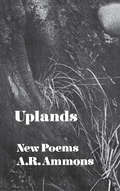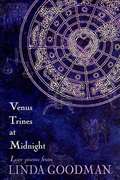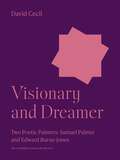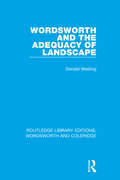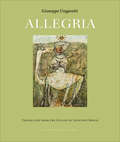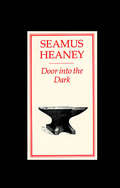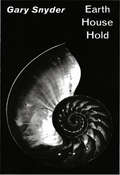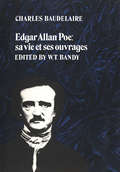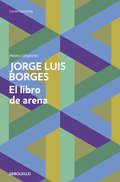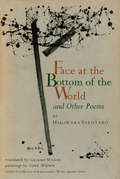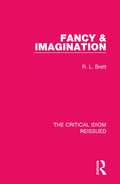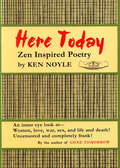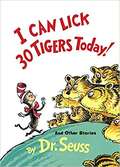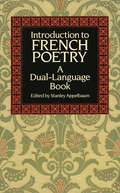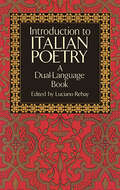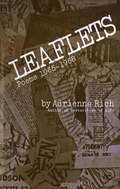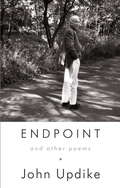- Table View
- List View
Uplands: New Poems
by A. R. AmmonsThis book collects many of the poems that A. R. Ammons wrote between 1964 and 1970. The poems here include brief lyrics and such longer works as "Summer Session 1968" and "Guitar Recicativos." The critic Harold Bloom writes, "With the publication of his Selected Poems (1968), soon after turning forty, A. R. Ammons quietly demonstrated a unique and central position in recent American poetry. . . . Recognition, as is always the case with a poetry difficult and central, has come slowly, but critics now begin to see in Ammons what he is: the maker of a body of poetry that fulfills Emerson's prophecy by addressing itself to life 'with sufficient plainness and with sufficient profoundness.'"
Venus Trines at Midnight
by Linda GoodmanLinda Goodman was born on an April day during a spring thunderstorm. In addition to her books on astrology, she published a book in 1990 called Croooerz, which is a brilliant, romantic, semi-autobiographical prose poem. Though she was the most highly-acclaimed astrology writer in the world, her greatest wish was to be known as a poet. With venus Trines at Midnight and the forthcoming Love Poems, she has made use of all her talents within the medium of poetry. And she hopes that people will enjoy these insightful poems and will remember her secret wish.
Visionary and Dreamer: Two Poetic Painters: Samuel Palmer and Edward Burne-Jones (The A. W. Mellon Lectures in the Fine Arts #15)
by David CecilAn eminent literary biographer and critic shows how poetry enriched the art of two representative English Romantic paintersIn Visionary and Dreamer, David Cecil evokes the century of the poet-painter, when painting drew much of its inspiration from imaginative literature. Samuel Palmer (1805–1881), an unworldly visionary, obscure in his lifetime but now a recognized master, and Edward Burne-Jones (1833–1898), the Pre-Raphaelite daydreamer, once revered as a great painter but later admired chiefly for his work in applied art, emerge as artists who turned to their own inner lives to interpret Shakespeare, Milton, and Keats.
Wordsworth and the Adequacy of Landscape (RLE: Wordsworth and Coleridge #12)
by Donald WeslingFirst published in 1970, this stylistic and interpretative account of some of Wordsworth’s major poetry examines description and meditation in his landscape writing. It describes the integration of two kinds of thinking, and a variety of beauties and lapses that come from their separation. Although Wordsworth’s deepest affinity was with nature, the author argues the finest landscape writing of the poet’s late twenties and early thirties derives from his attempt to humanise his love of nature. This work therefore aims to examine the way in which Wordsworth strives in his poetry to extend his range of concern from love of nature to love of mankind.
Allegria
by Giuseppe UngarettiGeoffrey Brock, whose translations have won him Poetry magazine's John Frederick Nims Memorial Prize and a Guggenheim Fellowship, finally does justice to these slim, concentrated verses in his English translation, alongside Ungaretti's Italian originals.Famed for his brevity, Giuseppe Ungaretti's early poems swing nimbly from the coarse matter of tram wires, alleyways, quails in bushes, and hotel landladies to the mystic shiver of pure abstraction. These are the kinds of poems that, through their numinous clarity and shifting intimations, can make a poetry-lover of the most stone-faced non-believer. Ungaretti won multiple prizes for his poetry, including the 1970 Neustadt International Prize for Literature. He was a major proponent of the Hermetic style, which proposed a poetry in which the sounds of words were of equal import to their meanings. This auditory awareness echoes through Brock's hair-raising translations, where a man holding vigil with his dead, open-mouthed comrade, says, "I have never felt / so fastened / to life."
Cuentos completos
by Jorge Luis BorgesPoeta, ensayista y narrador, Borges es una de las figuras primordiales de la literatura universal. Ahora, por primera vez, se reúnen en este volumen todos sus cuentos, uno de los legados más influyentes y deslumbrantes de la literatura occidental.El universo borgiano, con sus espejos, laberintos, tigres, bibliotecas, gauchos, o máscaras, es ya uno de los paisajes fundamentales del siglo XX. En este libro se encuentran obras maestras como El jardín de los senderos que se bifurcan, Pierre Menard, autor del Quijote, Funes el memorioso, El Sur, El Aleph o Ulrica.Leer estos cuentos supone releer la historia de la humanidad y emprender una de las aventuras más enriquecedoras, bellas y emocionantes de todos los tiempos.
Door into the Dark
by Seamus HeaneyDoor into the Dark, Seamus Heaney's second collection of poems, first appeared in 1969. Already his widely celebrated gifts of precision, thoughtfulness, and musicality were everywhere apparent.
Earth House Hold
by Gary SnyderBoth Pound and Williams have shown a good poet can revitalize prose style. Earth House Hold (a play on the root meaning of "ecology"), drawn from Gary Snyder's essays and journals, may prove a landmark for the new generation. "As a poet," Snyder tells us, "I hold the most archaic values on earth. They go back to the late Paleolithic; the fertility of the soil, the magic of animals, the power-vision in solitude, the terrifying intuition and rebirth; the love and ecstasy of the dance, the common work of the tribe." He develops, as replacement for shattered social structures. a concept of tribal tradition which could lead to "growth and enlightenment in self-disciplined freedom. Whatever it is or ever was in any other culture can be reconstructed from the unconscious through meditation...the coming revolution will close the circle and link us in many ways with the most creative aspects of our archaic past."
Edgar Allan Poe: sa vie et ses ouvrages
by Charles Baudelaire W. T. BandyThe earliest foreign study of the life and works of Edgar Allan Poe, the text presented in this volume is something of a landmark in the history of comparative literature. Baudelaire's first and longest essay on Poe was published in the Revue de Paris is 1852; it was revised and abridged for use as the preface of the first volume of his translation of Poe's tales, Histoires extraordinaires. This study was significant especially in the area of Franco-American literary relations because it was the basis of not only the French attitude toward Poe, but of his reputation throughout Europe--one might almost say, throughout the world. The essay on Poe has never been the subject of a separate publication. This edition reveals for the first time the sources of information used by Baudelaire. It shows that a considerable part of the study was translated literally from articles by John M. Daniel and John R. Thompson in the Southern Literary Messenger (1849-50). Previous editions vary widely in excellence because almost all suffered from the mistaken belief that Baudelaire was acquainted with the American edition of Poe's works when he wrote the 1852 essay and that it was largely based on Rufus Griswold's Memoir contained in that edition. This led to the commentary and notes that were unconsciously misleading and in many cases false.The introduction to this edition presents a complete and accurate account of the genesis of Baudelaire's essay, with supporting documents showing his indebtedness to American, French, and British sources. It enables the reader to distinguish clearly between what Baudelaire himself knew or thought about Poe and what he borrowed from other writers.
El libro de arena
by Jorge Luis Borges«Me dijo que su libro se llamaba El libro de arena, porque ni el libro ni la arena tienen ni principio ni fin.»El primero de los cuentos reunidos aquí retoma el tema del doble: los protagonistas de «El otro» son lo bastante distintos para ser dos y lo bastante parecidos para ser uno. «Ulrica» es la historia de un amor efímero. «El Congreso» describe una empresa tan vasta que se confunde con el cosmos y con la suma de los días. «Undr» y «El espejo y la máscara» son relatos sobre literaturas seculares que constan de una sola palabra, mientras que otras piezas imaginan objetos inconcebibles como un libro de infinitas páginas; un volumen impredecible y a la vez monstruoso: el libro de arena.
Face at the Bottom of the World and Other Poems
by Graeme Wilson Hagiwara Sakutaro York WilsonThe poetry of Hagiwara Sakutaro is still little known in the in the English-speaking world, though this is not altogether surprising when the importance of his work remains inadequately recognized in Japan itself. Nearly all Japanese critiques of post-Meiji poetry acknowledge Hagiwara as one of the best (if not, indeed, the very best) of modern Japanese poets; but almost all critics, having briefly made some such admission, thereafter shy away from him, strangely to devote long paragraphs to other poets patently less talented, sadly more diffuse and far less influential. Why? Perhaps the reason is that Hagiwara, for all his brilliance, seems somehow to switch on darkness, to radiate black luminance. In the beaconry of modern Japanese literature he is an occulting, rather than a flashing, light: but he remains nevertheless a lighthouse of supreme importance.
Face at the Bottom of the World and Other Poems
by Graeme Wilson Hagiwara Sakutaro York WilsonThe poetry of Hagiwara Sakutaro is still little known in the in the English-speaking world, though this is not altogether surprising when the importance of his work remains inadequately recognized in Japan itself. Nearly all Japanese critiques of post-Meiji poetry acknowledge Hagiwara as one of the best (if not, indeed, the very best) of modern Japanese poets; but almost all critics, having briefly made some such admission, thereafter shy away from him, strangely to devote long paragraphs to other poets patently less talented, sadly more diffuse and far less influential. Why? Perhaps the reason is that Hagiwara, for all his brilliance, seems somehow to switch on darkness, to radiate black luminance. In the beaconry of modern Japanese literature he is an occulting, rather than a flashing, light: but he remains nevertheless a lighthouse of supreme importance.
Fancy & Imagination (The Critical Idiom Reissued #5)
by R. L. BrettFirst published in 1969, this book provides a concise and helpful introduction to the terms ‘fancy’ and ‘imagination’. Although they are generally associated with Samuel Taylor Coleridge, the work begins with a discussion the history of these concepts which were also known to Aristotle, the Elizabethans, Hobbes, Locke and Blake. It then goes on to examine Coleridge’s theory of imagination and the distinction he drew between fancy and imagination. This work will be of particular interest to those studying Coleridge and the Romantic Movement.
Goblin Market
by Christina RossettiSisters Lizzie and Laura meet the goblin fruit sellers in the evening. Laura eats the fruit and begins to waste away from longing. Lizzie finds a way to trick the goblins and save her sister. Goblin Market was originally published in 1862 and has been republished several times since. At this time, very few stories had heroic females, but this poem provides a female who takes action - she deals with the sly goblins to save her sister, she does not wait passively for someone else to provide the rescue.
Here Today, Zen Poetry
by Ken NoyleHere is poetry as mod as flower children and hippies; a Warhol happening or sitar music. Ken Noyle is a "personal" poet who immediately demands his reader to be with him or agin him as he ruminates on many things he thinks are important. Those things include sex and marriage and God and nature and war and the position of the individual in relation to each. Ponderous? No. Rather, outrageous, iconoclastic, irreverent in a "let's look- at-this-together-and-see-what-we make-of-it vein." Noyle's amazing range between delicate sensitivity and outright earthiness reflects his study of Zen from which he has carried off a disarming senseof reality. To read and enjoy Ken Noyle is to learn a little more about one's self. What more can a poet hope for?
I Can Lick 30 Tigers Today! And Other Stories
by Dr SeussThe Cat in the Hat tells us three zany stories-in-verse about his son, his daughter, and his great-great-grandfather.
Introduction to French Poetry: A Dual-Language Book (Dover Dual Language French)
by Stanley AppelbaumImmerse yourself in great poetic tradition -- works by Villon, Ronsard, Voltaire, Lamartine, Hugo, Mallarmé, Verlaine, Rimbaud, Apollinaire, Saint-John Perse, Eluard and many more. Full texts in French with literal English translation on facing pages. Critical, biographical information on each poet. Introduction. 31 black-and-white illustrations.
Introduction to Italian Poetry: A Dual-Language Book (Dover Dual Language Italian)
by Luciano RebayThis anthology highlights seven centuries of Italian poetry that will help you learn the language as well. Included are 34 examples of Italian verse in the original with English translations on facing pages. Twenty-one poets are represented, from Saint Francis of Assisi, author of the first memorable Italian lyric, "Cancio delle creature," to Salvatore Quasimodo, winner of the 1959 Nobel Prize for Literature. Also included are works by Dante, Petrarch, Ariosto, Tasso, and Montale, as well as such lesser known but significant poets as Compiuta Donzella and Cavalcanti. There are even important works by Boccaccio and Michelangelo.In addition to full Italian texts with expert literal translations on facing pages, this edition contains a wealth of biographical and critical commentary.
Lazy Blackbird and Other Verses
by Jack PrelutskyThis is a nice collection of rhymes for young readers. Poems about animals claim several pages.
Leaflets: Poems 1965-1968
by Adrienne RichLeaflets is Adrienne Rich's fifth book of poems. It contains twenty-eight new poems, five adaptations of Dutch, Yiddish, and Russian poets, and a sequence of seventeen poems loosely based on the ghazal, a common form in Middle Eastern poetic tradition; these ghazals comprise a kind of notebook of a month in the summer of 1968. The themes of this book are the poetics of violence and the poetics of love. Its impulse is the deepening of recognitions through language, in a time of ignorance and mutilation. Miss Rich has written: "For a poet...there is this primary labor with words. But I have the notion that how you live your life has something to do with it--that morality, for a poet, is a refusal of blinders, of traditional consolations, a courage to be alone, or wounded....A willingness to step out into the fog, to take paths which may lead nowhere. Certainty, predictability, are the first supports that have to go. I see the poetry of things as standing in resistance to brute mechanistic force, the charge of the rhinoceros with its head down. To discover--literally--this poetry and re-create it in language is a poet's essential action."
Midpoint and Other Poems
by John UpdikeIn the boldly eclectic title poem of his collection, John Updike employs the meters of Dante, Spenser, Pope, Whitman, and Pound, as well as the pictographic tactics of concrete poetry, to take an inventory of his life at the end of his thirty-fifth year--at midpoint. These cantos form both a joke on the antique genre of the long poem and an attempt to write one: an earnest meditation on the mysteries of the ego, lost time, and the mundane. The remainder of the volume is a six years' harvest of light verse and incidental lyrics--poems dealing with love and death, animals and angels, places and persons, dream artifacts and the naked ape. As a writer of humorous verse Mr. Updike is alone in his generation; to serious poetry he brings the vision and warmth characteristic of his prose.
